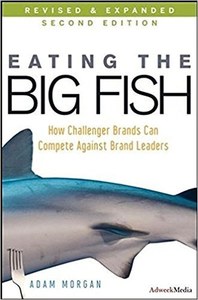Brand building in the digital age
My list combines the best of classic thinking about branding, how advertising builds brands, with some newer work that explains the design thinking behind the power brands of the digital revolution. My starting point is not brands but human psychology, the bedrock of brand understanding.

Thinking Fast and Slow – Daniel Kahnemann (Allen Lane 2011)
How do humans process information? Kahnemann shows that we are instinctive, lazy and don’t like to think hard. In fact, we are frequently irrational; we post-rationalise our instincts and use mental shortcuts to make decisions (such as picking the brand that seems most popular). His insights explain much that is successful in brand communications, whether it's for television or a new mobile application. Pleasure, like-ability, ease and simplicity tend to win.

Decoded: The Science Behind Why We Buy – Phil Barden (Wiley 2013)
The application of Kahnemann’s insights in the practice of brand communications. The book starts with a brilliantly simple explanation of System 1 and System 2 thinking and is packed with examples of behavioural science in action.

How Brands Grow (Books 1 and 2) – Byron Sharp (Oxford 2012 and 2016)
Sharp exposes the 'Loyal Buyer' fallacy; your brand's customers are really 'the buyers of other brands who occasionally buy your brand', in his view. Long-term brand health depends on continually being mentally and physically available to prospective and light buyers: they represent the most potential. This is bracing stuff if you believe that people care or think about brands (they don’t, it is mostly a need that prompts them to buy) or that they are brand loyal (they are not, they are prepared to buy from a repertoire). These books will wean you off your addiction to loyalty promotion and all manner of other delusions about brand.

Marketing in the Era of Accountability – Binet and Field (IPA 2007)
A hugely influential book about advertising effectiveness. The authors reviewed over 800 case histories in the IPA (Institute of Practitioners in Advertising)'s databank to draw out conclusions about what works best. Short answer: fame and emotional storytelling, which makes perfect sense if you read Kahnemann. As Antonio Damasio (a neuroscientist) once said – “we are not thinking machines that feel; we are feeling machines that think.”

Simply Better – Patrick Barwise and Sean Meehan (HBS 2004)
This book refutes the idea that brands have to offer something unique or highly distinctive to succeed in the long-term. Customers don’t want bells and whistles and don’t care about trivial differences between brands. What they really want are quality products, reliable services and fair value for money. The winning brands aim all the time to be 'simply better' at delivering these things.

Eating the Big Fish – Adam Morgan (Wiley 2009)
How do challenger brands break through? If Simply Better is on how big brands stay ahead, Morgan provides explanations as to how to disrupt a market and supplant the big incumbent brands. Successful challengers often lead with their beliefs and motivations (the 'why' not the 'what'), they seek fame/publicity, not just awareness and they often over-commit to a particular audience to achieve cut-through. In other words, great challenger brands tell good, shareable stories and that is what gets them talked about and gains the commitment of buyers in the early days.

Hooked: How to Build Habit-Forming Products – Nir Eyal (Portfolio Penguin 2014)
The brands that jostle for attention on your smartphone like Amazon, Facebook, Google and Snapchat are built differently from conventional brands. They seek to 'hook' you into using them habitually by designing themselves into your daily routines and 'scratching your itches'. These are the power brands of the digital revolution – and they are mainly built through the application of design thinking combined with a deep insight into what we find irresistible as humans.
There is a growing belief that a) these brands are too powerful and b) this is not good for human flourishing. So, it is useful to read Hooked in tandem with Move Fast and Break Things by Jonathan Taplin (Macmillan 2017), a book that argues this point of view powerfully. At some point, if not already, your brand will have to contend with these power brands that are planning to disrupt many markets. Good to know what you are up against.
Julian Saunders was Strategy Director, Ogilvy and Head of Strategy, McCann-Erickson and has worked on behaviour change campaigns for the UK Government and on innovation in The Zoo at Google. He blogs at www.joinedupthink.com


Comments (1) Closed